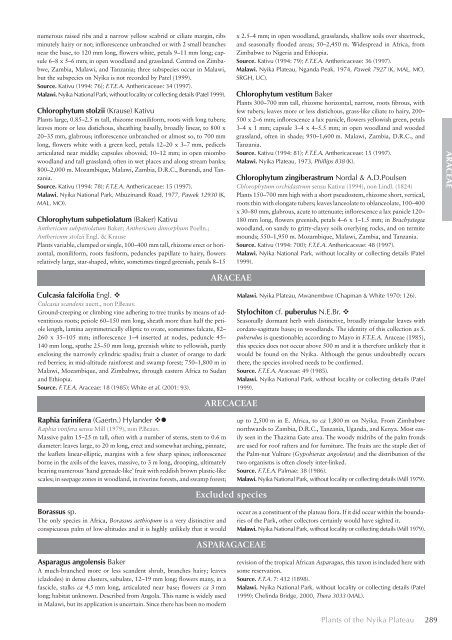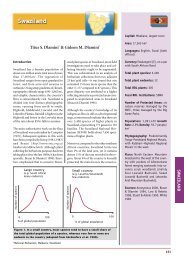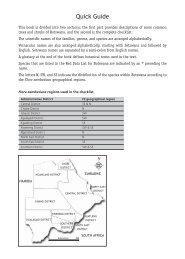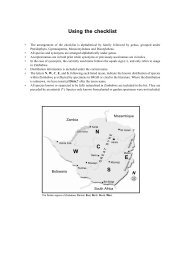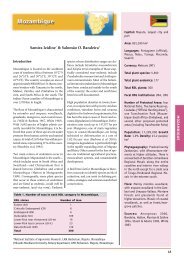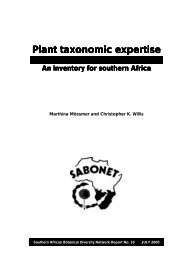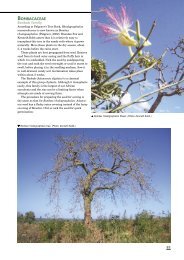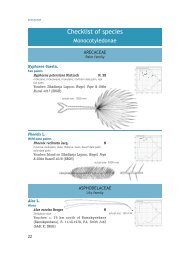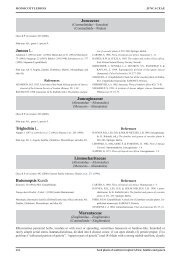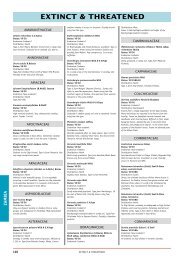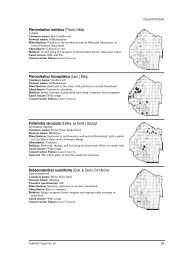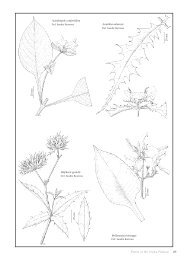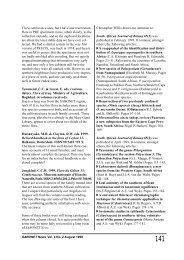266-299 - SABONET
266-299 - SABONET
266-299 - SABONET
You also want an ePaper? Increase the reach of your titles
YUMPU automatically turns print PDFs into web optimized ePapers that Google loves.
numerous raised ribs and a narrow yellow scabrid or ciliate margin, ribs<br />
minutely hairy or not; inflorescence unbranched or with 2 small branches<br />
near the base, to 120 mm long, flowers white, petals 9–11 mm long; capsule<br />
6–8 x 5–6 mm; in open woodland and grassland. Centred on Zimbabwe,<br />
Zambia, Malawi, and Tanzania; three subspecies occur in Malawi,<br />
but the subspecies on Nyika is not recorded by Patel (1999).<br />
Source. Kativu (1994: 76); F.T.E.A. Anthericaceae: 34 (1997).<br />
Malawi. Nyika National Park, without locality or collecting details (Patel 1999).<br />
Chlorophytum stolzii (Krause) Kativu<br />
Plants large, 0.85–2.5 m tall, rhizome moniliform, roots with long tubers;<br />
leaves more or less distichous, sheathing basally, broadly linear, to 800 x<br />
20–35 mm, glabrous; inflorescence unbranched or almost so, to 700 mm<br />
long, flowers white with a green keel, petals 12–20 x 3–7 mm, pedicels<br />
articulated near middle; capsules obovoid, 10–12 mm; in open miombo<br />
woodland and tall grassland; often in wet places and along stream banks;<br />
800–2,000 m. Mozambique, Malawi, Zambia, D.R.C., Burundi, and Tanzania.<br />
Source. Kativu (1994: 78); F.T.E.A. Anthericaceae: 15 (1997).<br />
Malawi. Nyika National Park, Mbuzinandi Road, 1977, Pawek 12930 (K,<br />
MAL, MO).<br />
Chlorophytum subpetiolatum (Baker) Kativu<br />
Anthericum subpetiolatum Baker; Anthericum dimorphum Poelln.;<br />
Anthericum stolzii Engl. & Krause<br />
Plants variable, clumped or single, 100–400 mm tall, rhizome erect or horizontal,<br />
moniliform, roots fusiform, peduncles papillate to hairy, flowers<br />
relatively large, star-shaped, white, sometimes tinged greenish, petals 8–15<br />
Culcasia falcifolia Engl. <br />
Culcasia scandens auctt., non P.Beauv.<br />
Ground-creeping or climbing vine adhering to tree trunks by means of adventitious<br />
roots; petiole 60–150 mm long, sheath more than half the petiole<br />
length, lamina asymmetrically elliptic to ovate, sometimes falcate, 82–<br />
260 x 35–105 mm; inflorescence 1–4 inserted at nodes, peduncle 45–<br />
140 mm long, spathe 25–50 mm long, greenish white to yellowish, partly<br />
enclosing the narrowly cylindric spadix; fruit a cluster of orange to dark<br />
red berries; in mid-altitude rainforest and swamp forest; 750–1,800 m in<br />
Malawi, Mozambique, and Zimbabwe, through eastern Africa to Sudan<br />
and Ethiopia.<br />
Source. F.T.E.A. Araceae: 18 (1985); White et al. (2001: 93).<br />
Raphia farinifera (Gaertn.) Hylander <br />
Raphia vinifera sensu Mill (1979), non P.Beauv.<br />
Massive palm 15–25 m tall, often with a number of stems, stem to 0.6 m<br />
diameter: leaves large, to 20 m long, erect and somewhat arching, pinnate,<br />
the leaflets linear-elliptic, margins with a few sharp spines; inflorescence<br />
borne in the axils of the leaves, massive, to 3 m long, drooping, ultimately<br />
bearing numerous ‘hand grenade-like’ fruit with reddish brown plastic-like<br />
scales; in seepage zones in woodland, in riverine forests, and swamp forest;<br />
Borassus sp.<br />
The only species in Africa, Borassus aethiopum is a very distinctive and<br />
conspicuous palm of low-altitudes and it is highly unlikely that it would<br />
Asparagus angolensis Baker<br />
A much-branched more or less scandent shrub, branches hairy; leaves<br />
(cladodes) in dense clusters, subulate, 12–19 mm long; flowers many, in a<br />
fascicle, stalks ca 4.5 mm long, articulated near base; flowers ca 3mm<br />
long; habitat unknown. Described from Angola. This name is widely used<br />
in Malawi, but its application is uncertain. Since there has been no modern<br />
ARACEAE<br />
ARECACEAE<br />
Excluded species<br />
ASPARAGACEAE<br />
x 2.5–4 mm; in open woodland, grasslands, shallow soils over sheetrock,<br />
and seasonally flooded areas; 50–2,450 m. Widespread in Africa, from<br />
Zimbabwe to Nigeria and Ethiopia.<br />
Source. Kativu (1994: 79); F.T.E.A. Anthericaceae: 36 (1997).<br />
Malawi. Nyika Plateau, Nganda Peak, 1974, Pawek 7927 (K, MAL, MO,<br />
SRGH, UC).<br />
Chlorophytum vestitum Baker<br />
Plants 300–700 mm tall, rhizome horizontal, narrow, roots fibrous, with<br />
few tubers; leaves more or less distichous, grass-like ciliate to hairy, 200–<br />
500 x 2–6 mm; inflorescence a lax panicle, flowers yellowish green, petals<br />
3–4 x 1 mm; capsule 3–4 x 4–5.5 mm; in open woodland and wooded<br />
grassland, often in shade; 950–1,600 m. Malawi, Zambia, D.R.C., and<br />
Tanzania.<br />
Source. Kativu (1994: 81); F.T.E.A. Anthericaceae: 15 (1997).<br />
Malawi. Nyika Plateau, 1973, Phillips 838 (K).<br />
Chlorophytum zingiberastrum Nordal & A.D.Poulsen<br />
Chlorophytum orchidastrum sensu Kativu (1994), non Lindl. (1824)<br />
Plants 150–700 mm high with a short pseudostem, rhizome short, vertical,<br />
roots thin with elongate tubers; leaves lanceolate to oblanceolate, 100–400<br />
x 30–80 mm, glabrous, acute to attenuate; inflorescence a lax panicle 120–<br />
180 mm long, flowers greenish, petals 4–6 x 1–1.5 mm; in Brachystegia<br />
woodland, on sandy to gritty-clayey soils overlying rocks, and on termite<br />
mounds; 550–1,950 m. Mozambique, Malawi, Zambia, and Tanzania.<br />
Source. Kativu (1994: 700); F.T.E.A. Anthericaceae: 48 (1997).<br />
Malawi. Nyika National Park, without locality or collecting details (Patel<br />
1999).<br />
Malawi. Nyika Plateau, Mwanembwe (Chapman & White 1970: 126).<br />
Stylochiton cf. puberulus N.E.Br. <br />
Seasonally dormant herb with distinctive, broadly triangular leaves with<br />
cordate-sagittate bases; in woodlands. The identity of this collection as S.<br />
puberulus is questionable; according to Mayo in F.T.E.A. Araceae (1985),<br />
this species does not occur above 500 m and it is therefore unlikely that it<br />
would be found on the Nyika. Although the genus undoubtedly occurs<br />
there, the species involved needs to be confirmed.<br />
Source. F.T.E.A. Araceae: 49 (1985).<br />
Malawi. Nyika National Park, without locality or collecting details (Patel<br />
1999).<br />
up to 2,500 m in E. Africa, to ca 1,800 m on Nyika. From Zimbabwe<br />
northwards to Zambia, D.R.C., Tanzania, Uganda, and Kenya. Most easily<br />
seen in the Thazima Gate area. The woody midribs of the palm fronds<br />
are used for roof rafters and for furniture. The fruits are the staple diet of<br />
the Palm-nut Vulture (Gypohierax angolensis) and the distribution of the<br />
two organisms is often closely inter-linked.<br />
Source. F.T.E.A. Palmae: 38 (1986).<br />
Malawi. Nyika National Park, without locality or collecting details (Mill 1979).<br />
occur as a constituent of the plateau flora. If it did occur within the boundaries<br />
of the Park, other collectors certainly would have sighted it.<br />
Malawi. Nyika National Park, without locality or collecting details (Mill 1979).<br />
revision of the tropical African Asparagus, this taxon is included here with<br />
some reservation.<br />
Source. F.T.A. 7: 432 (1898).<br />
Malawi. Nyika National Park, without locality or collecting details (Patel<br />
1999); Chelinda Bridge, 2000, Thera 3033 (MAL).<br />
Plants of the Nyika Plateau<br />
289<br />
ARACEAE


